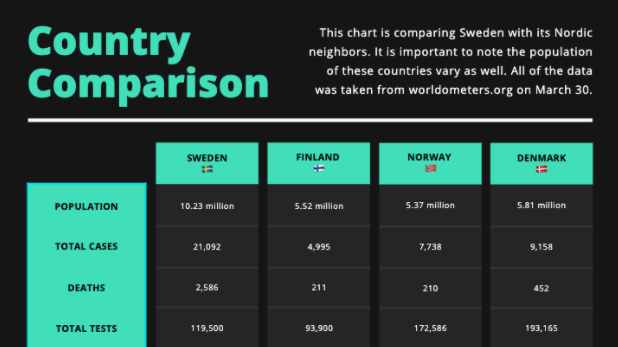Sweden’s distinct approach to the global pandemic
By Dillon George ‘22
People strolling in and out of bars, to and from classes, commuting to work. These everyday activities have stopped here in the U.S. due to the coronavirus, but they haven't stopped in one European country. Sweden. As opposed to many countries in the world, Sweden tackled the coronavirus in a much different manner, refraining from instating a lockdown or even closing down schools and bars.
Public health officials said that Swedish citizens could be trusted to stay at home, follow social distancing orders, and wash their hands without a mandatory order. The main goal was to lower transmission rates, in part by developing a herd immunity, defined by the New York Times as “a critical mass of infection that occurs in lower-risk populations that ultimately thwarts transmission.”
According to the top Swedish infectious disease official, an estimated 25% of Stockholm residents have been exposed to and are immune to the disease. The official also said that herd immunity, which might mean 80% of the population is immune, could be reached in Stockholm in a couple of weeks.
However, Stockholm isn’t the only part of Sweden. The numbers are not as well-known in other parts of the country, which is why celebrations can’t take place just yet.
Despite all of this, life is barely the same as it was before. Gatherings of over 50 people are still banned, sports have been cancelled, and museums closed. Senior care facilities have been closed since the end of March.
What does all of this mean? How do their numbers compare with countries who have imposed serious lockdowns? Here are some of those stats. (All as of April 30.)
There are 21,092 total cases in Sweden. Only 3% are in serious or critical condition, while 97% are in mild condition. The death rate, however, is more startling. Of 3467 total closed cases, 72% have ended in death, and only 28% recovered. Now, a factor of this is age. The virus spread through 75% of the 101 senior care homes in Stockholm.
Ewa Freyman Joas, a retired teacher living in Sweden, had this to say about these high death rates. “In Sweden the highest death rate is among elderly people over 70 living in homes for elderly. Terrible!”
Here is a chart simply comparing some of the statistics between Nordic countries.
Sweden has nearly double the population of the other countries listed. This gives good reason to why their number of total cases is a little more than double that of Denmark, but is a little high compared to Norway and Finland. What is most concerning is the number of deaths. Sweden has between 5-10 times as many deaths as the other countries, and of their total cases, over 10% have ended up in fatalities.
However, Freyman Joas wasn’t very keen on this comparison between Nordic countries. “Just because we are neighbors doesn’t mean you can compare us. You have to take in mind population, demography and how far in the pandemic each country is,” she said.
She raises a good point. 20% of Sweden is 65 years or older, 19.8% in Denmark, 16% of Finland, and only around 10% in Norway. Denmark and Sweden have the highest percentage of people above 70, and also the highest number of deaths. Freyman Joas also noted that in Helsinki, the lockdown had only lasted around a week.
But really, how has this affected everyday life? As Freyman Joas described it, “We don’t have to wear facemasks and we are allowed to be outside as much as we want to. We take long walks every day.” She mentioned that restaurants and bars are remaining open, however, they can be shut down if visitors are getting too close. Joas added that stores and businesses are “facing a terrible time with decline in customers and layoffs” but noted that that is a global problem, not just in Sweden.
As mentioned before, most schools have still remained open during the pandemic. As a former teacher, Joas said, “I used to work as a teacher and I am very happy that nursery schools and schools up to the gymnasium [16 -19 years old] have been open, not only for academic reasons but also for mental health.”
Mental illness has been a big struggle with Americans in the past months. COVID-19 has brought a huge spike in depression and mental illness in the U.S., a federal emergency hotline for people in distress registered a 1000% increase in April this year compared to April 2019.
The overall approval of the government’s response in Sweden is also high. Unlike in the U.S., according to Freyman Joas, a recent poll shows that over 60% of Swedes approve of the government strategy. She also said that her and her friends feel very happy and safe. “I am very proud of Sweden’s response to the pandemic,” she said.
Americans may want to jump on the herd immunity bandwagon, but there is a lot more that goes into the success rate. The main thing stopping the U.S. from taking a similar approach is the fact that Swedes are a lot healthier than Americans. Americans have significantly higher rates of diabetes and hypertension, two of the most risky underlying conditions. Developing herd immunity would mean a lot of Americans would need to self-quarantine for weeks, maybe even months. As seen around the nation, that idea is not very widely liked. Instead, social distancing is in place instead of a herd immunity approach so that the hospitals are not too overwhelmed.











By Ann Crosby ‘25
For months, anticipation surrounding the Donald Trump presidency has gripped the US population and gained worldwide attention.